Planetary nebula

A planetary nebula is an astronomical object belonging to the category of nebulae , consisting of an envelope of gas and plasma that was repelled by an ancient star at the end of its evolution .
The name is historical and misleading because these nebulae have nothing to do with planets . The name comes from the fact that they usually appear spherical in the telescope and look like distant gas planets .
The lifespan of planetary nebulae is usually no longer than a few tens of thousands of years. That is short compared to a “star life” with several million to many billions of years.
In the interstellar environment of the earth , a total of around 1500 copies are known in the galaxy, the Milky Way system.
Planetary nebulae play a crucial role in the chemical evolution of the galaxy, as the ejected material enriches interstellar matter with heavy elements such as carbon , nitrogen , oxygen , calcium and other reaction products of stellar nuclear fusion . In other galaxies , planetary nebulae are sometimes the only observable objects that provide enough information to learn about their chemical composition.
The Hubble Space Telescope was used to take pictures of many planetary nebulae. One fifth of the nebulae are spherical in shape. The majority, however, are complex and have different shapes. The mechanisms of the shaping are not yet exactly known. Possible causes could be companion stars , stellar winds or magnetic fields .
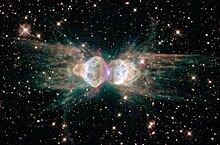
Observation history
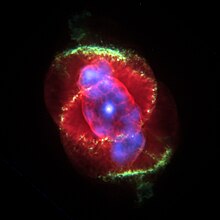
Planetary nebulae are generally weakly luminous objects and therefore cannot be observed with the naked eye. The first planetary nebula discovered was the Dumbbell Nebula in the constellation Fox . It was discovered by Charles Messier in 1764 and is listed in his catalog with the index M 27.
Due to the relatively low optical resolution of the telescopes of that time, a planetary nebula looked like a tiny, foggy disk. Since the planet Uranus, discovered in 1781, offered a similar sight, its discoverer Wilhelm Herschel introduced the name for these nebulae, which has been retained until today , in 1785.
The composition of planetary nebulae remained unknown until the first spectroscopic observations were made in the mid-19th century . William Huggins was one of the first astronomers to study the light spectrum of astronomical objects by spectrally splitting their light with the help of a prism . His observations of stars showed a continuous spectrum with some dark absorption lines . A little later he found out that some foggy objects, such as the “Andromeda Nebula” , had a very similar spectrum. These nebulae later turned out to be galaxies . However, when Huggins observed the Cat's Eye Nebula , he found a very different spectrum. This was not continuous with a few absorption lines, but only had a few emission lines . The brightest line had a wavelength of 500.7 nm. This was unrelated to any known chemical element. At first it was assumed that it was an unknown element, which was then given the name nebulium .
In 1868, the previously unknown element helium was discovered while studying the spectrum of the sun . Although it was possible to detect and isolate helium in the earth's atmosphere shortly after this discovery , nebulium was not found. At the beginning of the 20th century, Henry Norris Russell suggested that it was not a question of a new element that produced the wavelength 500.7 nm, but rather a known element in unknown proportions.
In the 1920s, physicists demonstrated that the gas in the planetary nebulae has an extremely low density . Electrons can reach metastable energy levels in the atoms and ions that otherwise can only exist for a short time at higher densities due to the constant collisions. Electron transitions in oxygen lead to an emission at 500.7 nm. Spectral lines that can only be observed in gases with very low densities are called forbidden lines .
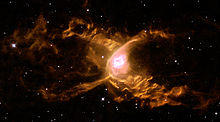
Until the beginning of the 20th century it was assumed that planetary nebulae represent the precursors of stars. It was believed that the nebulae contracted under their own gravity and formed a star in the center. However, later spectroscopic studies showed that all planetary nebulae are expanding. It was found that the nebulae represent the repulsed outer layers of a dying star that remains in the center as a very hot, but faint object.
Towards the end of the 20th century, advancing technology helped to better understand the evolution of the planetary nebulae. Using space telescopes , astronomers have also been able to study emitted electromagnetic radiation outside the visible spectrum, which, due to the earth's atmosphere , cannot be observed by ground-based observatories . By observing the infrared and ultraviolet radiation components of the planetary nebulae, one can determine their temperature, density and chemical composition much more precisely. With the help of CCD techniques, the spectral lines can be determined much more precisely and even extremely weak lines can be made visible. Planetary nebulae, which had simple and regular structures in ground-based telescopes, showed very complex shapes as a result of the high resolution of the Hubble space telescope.
Emergence
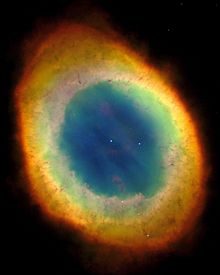
Planetary nebulae represent the final stages of an average star like our sun.
A typical star has less than twice the solar mass . Its energy is generated in the core, in which the nuclear fusion of hydrogen to helium takes place. The resulting radiation pressure prevents the star from collapsing due to its own gravity . A stable state is established that can last for billions of years.
After billions of years, the core of hydrogen is depleted. The radiation pressure decreases, the core is compressed by the gravitational forces and heats up. During this phase, the temperature in the core rises from 15 million to 100 million Kelvin . In the core, helium now fuses to carbon and oxygen , in the “shell” around the core, hydrogen fuses to form helium. As a result, the shell of the star expands sharply, it enters the stage of a red giant on the asymptotic giant branch .
The helium fusion mentioned is very temperature-sensitive: the reaction speed is proportional to the 30th power of the temperature and therefore doubles with a temperature increase of only 2.3%. This makes the star very unstable - a small increase in temperature immediately leads to a significant increase in the rate of reaction , releasing significant energies, causing the temperature to continue to rise. The layers in which the helium fusion is currently taking place expand at high speed and thereby cool down again, which reduces the reaction rate again. The result is a strong pulsation that is sometimes strong enough to hurl the entire stellar atmosphere into space.
The gas in the star's envelope initially expands at a speed of 20 to 40 km / s and has a temperature of around 10,000 K. This comparatively slow stellar wind forms the main mass of the nebula. As the star gradually loses its outer shells and exposes the ever hotter core, its color changes from orange to yellow to white and finally blue - a visible sign that its surface temperature is rising to over 25,000 K. . When the exposed surface is around 30,000 K, enough high-energy ultraviolet photons are emitted to ionize the previously ejected gas . The gas envelope becomes visible as a planetary nebula. The star in the center has reached the stage of a white dwarf .
Duration of visibility
The gases emitted by the planetary nebulae move away from the center at a speed of a few kilometers per second. The stellar wind subsides completely over time, and the gas recombines , making it invisible. For most planetary nebulae, the time span between formation and recombination is approximately 10,000 years.
Galactic producers of elements
Planetary nebulae play an important role in the evolution of a galaxy. The early universe was almost entirely made up of hydrogen and helium . It was only through the nucleosynthesis taking place in the stars that the heavier elements were created, which are also called metals in astrophysics . Planetary nebulae also consist to a considerable extent of elements such as carbon, nitrogen and oxygen, with which they enrich the interstellar medium.
Subsequent star generations consist to a small extent of these heavier elements, which have an influence on star evolution. The planets consist to a large extent of heavy elements.
In addition to the planetary nebulae, supernova explosions also emit heavy elements in the final phase of massive stars.
properties
Physical Properties

The star in the center heats the gases to a temperature of around 10,000 K with its radiation. Typical planetary nebulae are made up of around 70% hydrogen and 28% helium. The remaining part is mainly made up of carbon, nitrogen and oxygen as well as traces of other elements.
They have a diameter of around one light year and consist of extremely dilute gas with a density of around 10 3 particles per cubic centimeter, “young” planetary nebulae reach up to 10 6 particles per cubic centimeter. Over time, the expansion of the nebula reduces its density.
Contrary to expectations, the gas temperature is usually higher the further you move from the center. This is because high-energy photons are absorbed less often than less high-energy ones. In the edge areas of the nebula, the low-energy photons have already been absorbed and the remaining high-energy photons lead to the greater temperature increase.
Planetary nebulae are described as either "matter-limited" or "radiation-limited":
- in matter-limited planetary nebulae, there is not enough gas around the star to absorb all of the ultraviolet photons emitted by the central star. The gas is thus completely ionized and the visible limit of the fog is determined by the amount of gas present.
- In the case of planetary nebulae with limited radiation, however, the radiation emitted by the central star is insufficient to ionize all of the gas. The nebula is thus surrounded by neutral gas, and the visible boundary of the nebula results from the amount of radiation present.
Mists containing regions of ionized hydrogen are called emission nebulae . For the most part, they consist of a plasma in which ionized hydrogen (protons) and free electrons occur. In contrast to a “simple” gas, the plasma gives the fog characteristic properties such as magnetic field, plasma double layers , synchrotron radiation and plasma instabilities .
Number and occurrence
Currently, around 1500 planetary nebulae are known in our galaxy, which consists of around 200 billion stars. This small number becomes understandable when one sees the very short existence of the nebulae in relation to the entire “star life”. Planetary nebulae are mostly found around the plane of the Milky Way, with the greatest concentration in the Galactic Center . Only one or two planetary nebulae in star clusters are known.
Recently, a systematic photographic survey of the sky has dramatically increased the number of known planetary nebulae. Although CCDs have already replaced chemical film in modern astronomy, a Kodak Technical Pan film was used. In combination with a special filter for the isolation of the typical hydrogen lines that occur in all planetary nebulae, very faint objects could also be detected.
shape

In general, planetary nebulae are symmetrical and roughly spherical in shape, but very diverse and complex shapes also exist. About 10% are strongly bipolar, some are asymmetrical ; the retina nebula is even rectangular when viewed from Earth.
The causes of the extreme diversity of forms are not yet known precisely and are discussed controversially. Gravitational effects of companion stars could contribute to the shaping. Another possibility would be that massive planets disrupt the flow of matter when the nebula is forming. In January 2005, a magnetic field was first found around the central stars of two planetary nebulae. It is believed that this field is partially or fully responsible for the extraordinary structure.
In 2011, the Hubble Space Telescope photographed a planetary nebula in the constellation Arrow , the 'Necklace Nebula', which consists of a ring of glowing gas nodes that sparkle like diamonds on a necklace.
Current research subject
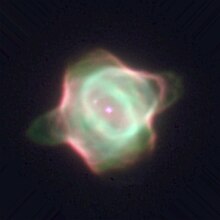
A major problem with studying planetary nebulae is that it is difficult to determine their distance. With relatively close planetary nebulae, the distance can be determined with the help of parallax . Because of the small number of nearby nebulae and the variety of shapes, however, no benchmark can be derived from this. If the distance is known, years of observation can be used to determine the speed of expansion of the nebula perpendicular to the direction of observation. The spectroscopic investigation of the Doppler effect also gives the expansion speed in the direction of observation.
The proportion of the heavy elements in planetary nebulae can be determined by two methods, with the results sometimes differing widely. Some astronomers suggest this could be due to temperature fluctuations within the nebulae. Others, however, are of the opinion that the differences are too great to explain them with this temperature effect and attribute the differences to cold areas with very little hydrogen. However, such areas have not yet been observed.
See also
literature
- Luboš Kohoutek : Catalog of galactic planetary nebulae (= treatises from the Hamburg observatory. No. 12, ISSN 0374-1583 ). 2 volumes (Vol. 1: Catalog. Vol. 2: Charts. ). Updated Version 2000. Hamburg Observatory, Hamburg-Bergedorf 2001.
- Sun Kwok: The origin and evolution of planetary nebulae (= Cambridge Astrophysics Series. Vol. 33) Cambridge University Press, Cambridge et al. 2000, ISBN 0-521-62313-8 .
- Harm J. Habing, Henny JGLM Lamers (Eds.): Planetary nebulae. Proceedings of the 180th Symposium of the International Astronomical Union, held in Groningen, The Netherlands, August, 26-30, 1996. Kluwer Academic, Dordrecht et al. 1997, ISBN 0-7923-4892-3 .
- Grigor A. Gurzadyan: The physics and dynamics of planetary nebulae. Springer, Berlin et al. 1997, ISBN 3-540-60965-2 .
- Holger Marten: Time-dependent effects in the development of planetary nebulae and their significance for the interpretation of observations. Kiel 1993 (Kiel, University, dissertation, 1994).
- Ralf Napiwotzki: Analysis of central stars of old planetary nebulae and related objects. Kiel 1993 (Kiel, University, dissertation, 1993).
Web links
- scinexx .de: Cosmic Veils of Fog August 27, 2004
- ESO: SPHERE Reveals Earliest Stages of Planetary Nebula June 10, 2015
- ESO: The Ghost of a Dying Star August 5th, 2015
Individual evidence
- ↑ https://digipress.digitale-sammlungen.de/view/bsb10531708_00123_u001/3
- ↑ Hubble Offers a Dazzling 'Necklace' (accessed August 18, 2011)